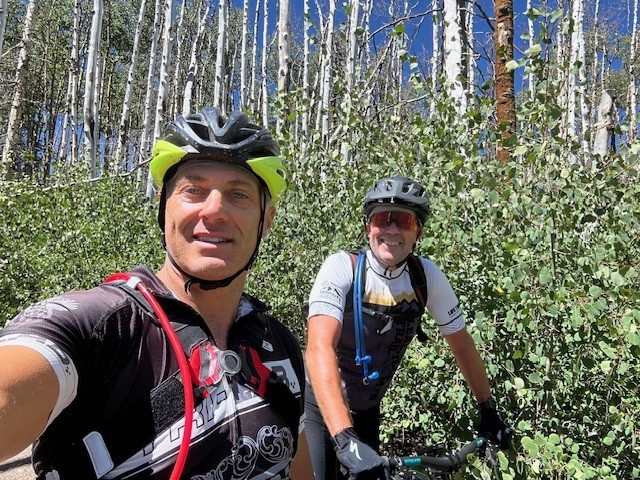Moab, Utah, has become famous in large part because of its Mars-like terrain. But what keeps mountain bikers coming back is the quality of the riding here. Considering a trip to this world-renowned outdoor destination? Keep reading to learn about seven of Moab’s top-rated mountain-biking trails.
Captain Ahab
This popular trail begins with a one-mile ascent up HyMasa, an intermediate-level climb. From there, riders can either head back downhill or continue on to the rest of the largely slickrock trail. Be warned: Those who choose the latter should be prepared for a technical route that’s suitable only for advanced riders—or intermediate-level ones looking to up their skills. Captain Ahab is decidedly not for beginners.
Captain Ahab’s signature feature is its fast descents, which require strong bike-handling skills and can easily result in a trip to the emergency room if not navigated properly. Lower Ahab has the most death-defying drops, while Upper Ahab mixes in climbing with more technical aspects. Those opting for the full Captain Ahab loop should save their energy for the final, highly technical half-mile.
Dead Horse Point
Families, along with beginner and intermediate riders, will find plenty to love at this flat trail network. Located in a state park of the same name, Dead Horse Point offers miles of single-track trails with plenty of options to create your own route. Directionally challenged? Don’t worry: the trails are clearly mapped and marked.
Positioned on a mesa, Dead Horse Point overlooks Canyonlands National Park and offers some of the best views in Moab. These views can be taken in without having to get close to the edge, a plus for families. Class 1 pedal-assist e-bikes are allowed here to more easily navigate the mix of slickrock, hard-packed, and sandy-wash surfaces.
Klondike Bluffs
A cross between Captain Ahab and Dead Horse Point, Klondike Bluffs offers technical climbing along with more relaxed options for beginner and intermediate riders.
Ascending Klondike Bluffs is a challenge that requires moderate endurance and strength, as well as intermediate bike-handling skills. As you pedal, see if you can spot the dinosaur tracks. Remember that technical ascents require technical descents, so leave enough energy for the trip down.
For an easier day, stick to the lower part of the bluff, where there are many loop and trail options for the beginner and intermediate crowd. Dino Flow, for instance, can be linked with other beginner trails to make an easy loop or used as a warmup for a climb up the bluff. Because of its variety, Klondike Buffs is great choice for groups with riders of various skill levels.
Magnificent 7
Magnificent 7 comprises seven trails that, when linked together, take mountain bikers on a remarkable 20-plus-mile descent. The average grade is 5 percent, but some sections are as steep as 20 percent. In part because of the extreme exposure—the fall risk is so great in certain sections that signs warn riders to dismount and walk their bikes—this is an expert-only trail.
Those not yet ready for the entirely of Magnificent 7 can practice their skills on the first of its seven trails. Known as Bull Run, it features challenging but not death-defying drops, ledges, and other features. Descend Bull Run, then pedal back up the road for another round.
The exposure and difficulty increases the father you get down the mountain, so again, only true expert-level riders should attempt. Those who do will find fast sections along ledges as well as picturesque views. Magnificent 7’s one sustained climbing section, Gold Bar, can be punishing in the sun, so consider tackling it early in the day.
Navajo Rocks
Those wanting to understand the appeal of Moab in only one trail couldn’t do much better than Navajo Rocks. Fast red slickrock, beautiful desert views, challenging technical sections, fast descents—Navajo Rocks has all of Moab’s signature traits.
Navajo Rocks consists of two loops that can be combined for a 17-plus-mile ride. If you have to choose, experts recommend the nine-mile eastern loop, which will take you up Rocky Tops and down Ramblin’.
Navajo Rocks is good both for intermediate and advanced riders, the latter of whom may consider using it as a warmup. Parking is conveniently located at the halfway point of the full loop, making it easy for you to refuel yourself mid-ride.
Slickrock
One of Moab’s first mountain-biking trails is one of its most famous. Located in Sand Flats Recreation area, Slickrock provides a great introduction to desert riding.
Pedaling through the desert here is a surreal experience thanks to the seemingly alien red slickrock—which, despite its name, is actually extremely grippy. Rock bulges create intermediate-level ascents and descents, though some mountain bikers consider parts of the nine-mile loop suitable for beginners or even difficult enough for more advanced riders. If you’re ensure of your skills, test them on Slickrock’s one-mile practice trail.
The Whole Enchilada
This world-famous trail’s name is a reference the fact there’s seemingly every type of terrain imaginable here. With a 7,000-foot descent that stretches for more than 25 miles, the Whole Enchilada is an experience you won’t soon forget.
Accessing the downhill section requires making a 1,000-foot ascent up Burro Pass. While short, it’s a punishing climb. From there, begin your descent toward the Colorado River. While there are many technical sections, the terrain here is less challenging than expert-level trails like Magnificent 7. What makes the Whole Enchilada difficult is the high level of endurance required to complete it. As such, it’s appropriate only for advanced and expert riders.
Mountain bikers should remember to dress warmly—the weather here is always cold, even when it’s hot in Moab. Because the Whole Enchilada is far from town, and there’s no quick way to get back, riders should also be sure to bring plenty of food, water, and supplies.

